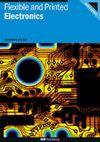弹性体封装辅助稳定柔性电子基板的拉伸模式变形分析
IF 3.2
4区 工程技术
Q3 MATERIALS SCIENCE, MULTIDISCIPLINARY
引用次数: 1
摘要
基板在柔性器件和传感器中起着重要作用。在这个方向上,观察到弹性体封装有助于传感器系统在拉伸下成功变形。这种封装不仅使其具有灵活性,而且可以保护其免受环境因素和机械损伤。在本文中,使用有限元方法分析来研究封装系统的机械效应,这为柔性电子系统的可拉伸基板的设计提供了见解。在这里,在聚对苯二甲酸乙二醇酯基底上设计了蛇形银电极,然后用聚二甲基硅氧烷封装。随着顶部与底部封装厚度之比(即T en1:T en2)的变化,研究了界面应力。T en1和T en2的失配可能导致压缩弯曲应变,这可以通过使T en1=T en2来避免。从模拟中可以观察到,当施加拉伸模式变形时,在衬底和封装的界面处,von Mises应力出现尖峰。此外,该最大应力随着封装厚度的变化而变化。对于总封装厚度范围,即T EN=T en1+T en2=30μm至100μm,发现最佳厚度为55μm,其中界面von Mises应力峰值最小。本文章由计算机程序翻译,如有差异,请以英文原文为准。
Stretching mode deformation analysis for an elastomeric encapsulation-assisted stable flexible electronic substrate
The substrate plays an important role in flexible devices and sensors. In this direction, it is observed that elastomeric encapsulation assists the sensor system to deform successfully under stretching. The encapsulation not only makes it flexible but also protects it from environmental factors and mechanical damage. In this paper, a finite element method analysis is used to study the mechanical effects on the encapsulated system, which provides insight into the design of a stretchable substrate for flexible electronic systems. Here, a serpentine silver electrode is designed on a polyethylene terephthalate substrate, which is then encapsulated by polydimethylsiloxane. With the variation in the ratio of top-to-bottom encapsulation thickness i.e. T en1: T en2, the interfacial stress was studied. The mismatch in T en1 and T en2 may result in compressive bending strain, which can be avoided by making T en1 = T en2. It is observed from the simulation that, there is a spike in von-Mises stress at the interface of the substrate and the encapsulation when stretching mode deformation is applied. Also, this maximum stress varies with the variation in encapsulation thickness. For a range of total encapsulation thickness i.e. T EN = T en1 + T en2 = 30 μm to 100 μm, the optimum thickness is found to be 55 μm, for which the spike in interfacial von-Mises stress is minimum.
求助全文
通过发布文献求助,成功后即可免费获取论文全文。
去求助
来源期刊

Flexible and Printed Electronics
MATERIALS SCIENCE, MULTIDISCIPLINARY-
CiteScore
4.80
自引率
9.70%
发文量
101
期刊介绍:
Flexible and Printed Electronics is a multidisciplinary journal publishing cutting edge research articles on electronics that can be either flexible, plastic, stretchable, conformable or printed. Research related to electronic materials, manufacturing techniques, components or systems which meets any one (or more) of the above criteria is suitable for publication in the journal. Subjects included in the journal range from flexible materials and printing techniques, design or modelling of electrical systems and components, advanced fabrication methods and bioelectronics, to the properties of devices and end user applications.
 求助内容:
求助内容: 应助结果提醒方式:
应助结果提醒方式:


